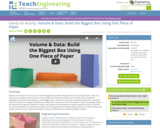
Students look for break apart irregular polygons to make arrays to find the area of these common shapes.
- Subject:
- Mathematics
- Material Type:
- Lesson Plan
- Provider:
- BetterLesson
- Date Added:
- 12/01/2022

Students look for break apart irregular polygons to make arrays to find the area of these common shapes.

Students apply what they know about area of other polygons to develop a formula for finding the area of a triangle.

Creating rooms with different dimensions but the same area improves understanding of multiplicative principles.

1, 2, 3,... Students will demonstrate their counting ability as they count sets of objects between 40-60.

Analyzing the work of others to determine if it meets the criteria for building a nest box.

Students will be able to use strategies to solve real-world problems involving area and perimeter.

Students will be able to use strategies to solve real-world problems involving area and perimeter.

Area comes alive when you design your own space.

How can you represent the area of a diagram using numerical expressions? Students apply their knowledge of area and order of operations to match area diagrams with numerical expressions.

How can you represent the area of a diagram using numerical expressions? Students connect their knowledge of area and equivalent expressions to the commutative and distributive properties for day 2 of this investigation.

Students decompose an irregular polygon into arrays to find the area.

Students use the area formula for rectangles to solve real world and mathematical problems.

Students solve real-world and mathematical problems involving area, volume and surface area.

Breaking figures into smaller squares and rectangles allows me to multiply to find the area

Connect new measurement knowledge and skills to the students' immediate environment.

This lesson focuses on the addition measurement of perimeter using real world examples.

Subtraction problems can involve shapes, attributes and perimeter.

Area is the concept of covering a region with "unit squares".

In the following video Paul Andersen explains how the gas pressure is the force applied over the area of the container. It is also the change in momentum as gas molecules interact with the container and is uniform throughout the sample. Several problems including pressure, force and area are included. [5:39]

Student pairs are given 10 minutes to create the biggest box possible using one piece of construction paper. Teams use only scissors and tape to each construct a box and determine how much puffed rice it can hold. Then, to meet the challenge, they improve their designs to create bigger boxes. They plot the class data, comparing measured to calculated volumes for each box, seeing the mathematical relationship. They discuss how the concepts of volume and design iteration are important for engineers. Making 3-D shapes also supports the development of spatial visualization skills. This activity and its associated lesson and activity all employ volume and geometry to cultivate seeing patterns and understanding scale models, practices used in engineering design to analyze the effectiveness of proposed design solutions.